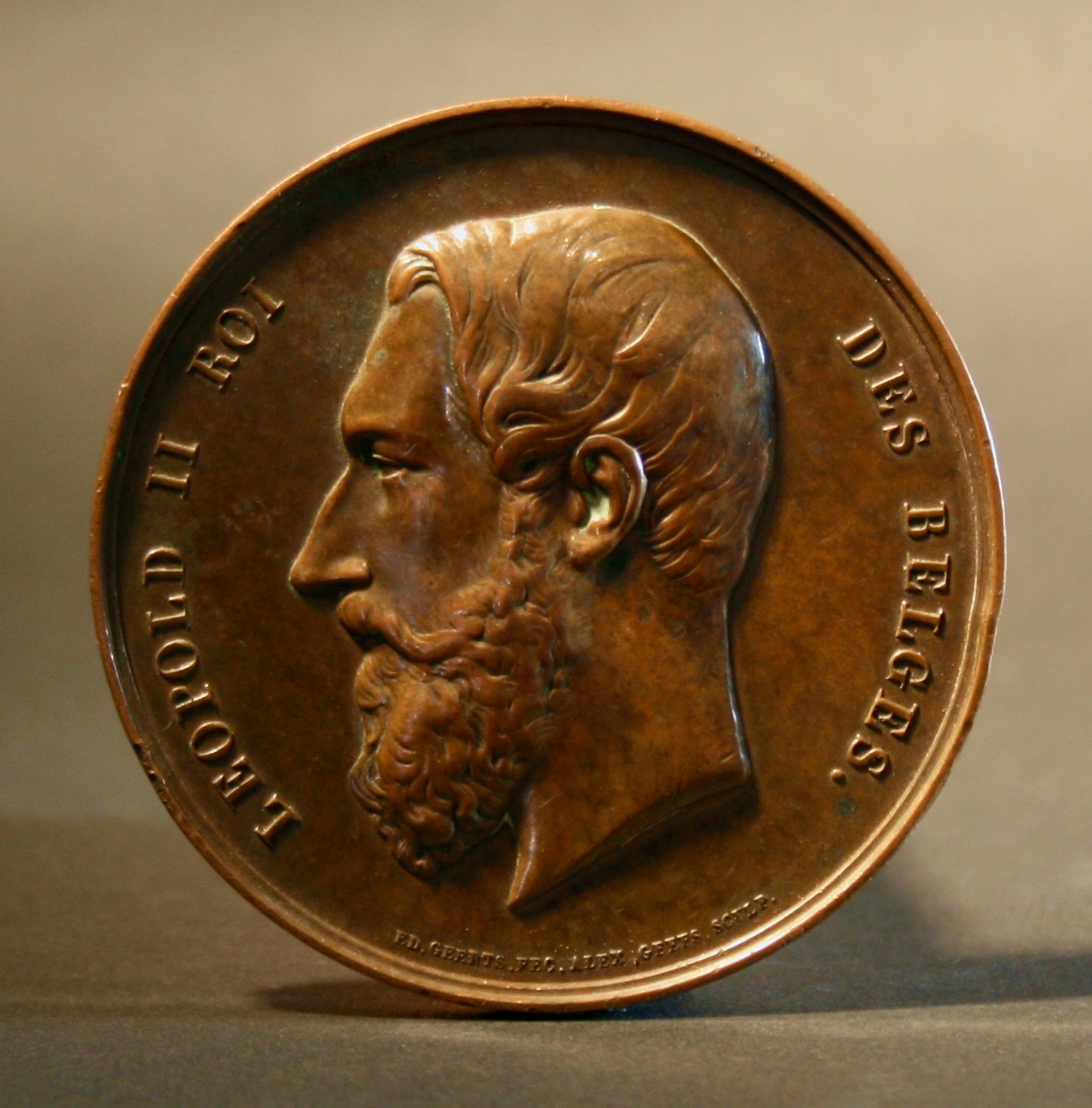

Title: King Leopold II Bronze Commemorative Medal First Annual Music Festival
Shipping: $29.00
Artist: N/A
Period: 19th Century
History: Art
Origin: Central Europe > Belgium
Condition: Good
Item Date: N/A
Item ID: 534
King Leopold II Bronze Medal: First Annual Music Festival in Brussels, 1869, 65mm This exquisite 2 1/2-inch medal is in outstanding condition, weighing 121.2 grams. This particular medal was created for the Belgian music festival in 1869. Artists: Edouard Louis Geerts / Alexandre Georges Geefs Country of Origin: Belgium, Year: 1869, Material: Bronze, Diameter: 65 mm Obverse (Front): Left-facing bust of Leopold II with the inscription "LEOPOLD II, ROI DES BELGES" (Leopold II, King of the Belgians). Reverse (Back): Depiction of Belgium holding a scepter, flanked by Victory and the City of Brussels. Victory holds a tablet inscribed with "1ER FESTIVAL ANNUEL A BRUXELLES 28 SEPT. 1869" (1st Annual Festival in Brussels, September 28, 1869). The City of Brussels holds a scroll inscribed with "FESTIVAL ANNUEL DE MUSIQUE CLASSIQUE DÉCRÉTÉ EN 1868" (Annual Festival of Classical Music Enacted in 1868). Signatures: On the obverse: "ED. GEERTS. FEC. ALEX. GEEFS. SCULP." On the reverse: "ALEX. GEEFS. FEC." The government, with the aim of establishing a federation of musical societies in Belgium, allocated a budget to organize a grand annual festival of classical music. This medal was issued to commemorate the inaugural event and was presented to all the performers, chorus singers, and instrumentalists. the Belgium music festival in 1869. Here's some information about the medal and its significance: Description: The medal is made of bronze and measures 65 mm (approximately 2 1/2 inches) in diameter. It weighs 121.2 grams, making it a substantial and significant piece. Medal Design: The obverse (front) of the medal features a bust of Leopold II, who was the King of the Belgians at that time. The inscription "LEOPOLD II, ROI DES BELGES" translates to "Leopold II, King of the Belgians." This side of the medal honors the reigning monarch. Reverse Design: On the reverse (back) of the medal, you can find a depiction of Belgium holding a scepter. Flanking her are figures representing Victory and the City of Brussels. Victory holds a tablet inscribed with "1ER FESTIVAL ANNUEL A BRUXELLES 28 SEPT. 1869," which translates to "1st Annual Festival in Brussels, September 28, 1869." The City of Brussels holds a scroll with the inscription "FESTIVAL ANNUEL DE MUSIQUE CLASSIQUE DÉCRÉTÉ EN 1868," which means "Annual Festival of Classical Music Enacted in 1868." This side of the medal commemorates the annual classical music festival that took place in Brussels in 1869. Artists: The medal was created by two Belgian artists, Edouard Louis Geerts and Alexandre Georges Geefs. Their names are inscribed on the medal, indicating their involvement in its design and production. Historical Significance: This medal is a historical artifact that represents the cultural and musical significance of the annual classical music festival in Brussels during the reign of Leopold II. It's a testament to the importance placed on classical music and the arts in Belgium during that period. Condition: The fact that the medal is in excellent condition is noteworthy for collectors and historians, as it ensures that the medal retains its original beauty and historical value. Overall, this medal is a valuable and fascinating piece of Belgian history and art, reflecting the cultural and artistic achievements of the time and the support for classical music in Belgium during the late 19th century.
Commemorative medal portraits of King Leopold II of Belgium have a rich history that spans several decades. Leopold II, who reigned from 1865 to 1909, was known for various achievements and controversies during his reign, and these medals were created to mark important events, milestones, and accomplishments associated with his rule. Here's a brief overview of the history of commemorative medal portraits of King Leopold II: Early Reign and Achievements: During the early years of Leopold II's reign, medals were struck to celebrate significant accomplishments. These included events like the inauguration of public buildings, the completion of infrastructure projects, and other developments aimed at modernizing Belgium. Colonial Endeavors: King Leopold II is perhaps most notorious for his involvement in the Congo Free State (later known as the Belgian Congo). Medals were issued to commemorate his role in promoting colonial expansion in Africa, particularly in connection with the Brussels Geographic Conference of 1876, where plans for colonization were discussed. Art and Culture: Leopold II was also a patron of the arts and a supporter of cultural initiatives. Medals were created to mark cultural events, such as music festivals, exhibitions, and other cultural achievements. The medal mentioned in your initial question, commemorating the 1869 music festival in Brussels, is an example of such a cultural medal. Longevity of Rule: Leopold II's lengthy reign of over 44 years marked a significant period in Belgian history. Commemorative medals were issued to celebrate his long tenure on the throne, such as medals marking his silver and golden jubilees. Social and Political Events: Medals were also created to commemorate various social and political events during his reign, including royal weddings, births, and diplomatic missions. Legacy and Controversy: In the decades following Leopold II's reign, there has been considerable debate and controversy surrounding his colonial policies, particularly in the Congo. Some medals bearing his image have become symbols of the atrocities and human rights abuses associated with his rule. Collector's Items: Today, many of these commemorative medals are sought after by collectors and historians for their historical significance and artistic value. They offer insights into the cultural, political, and social milieu of the time. In summary, the history of commemorative medal portraits of King Leopold II of Belgium reflects a wide range of events and aspects of his reign, from cultural achievements to colonial endeavors. These medals continue to be studied and collected, shedding light on the complex legacy of one of Belgium's longest-reigning monarchs.